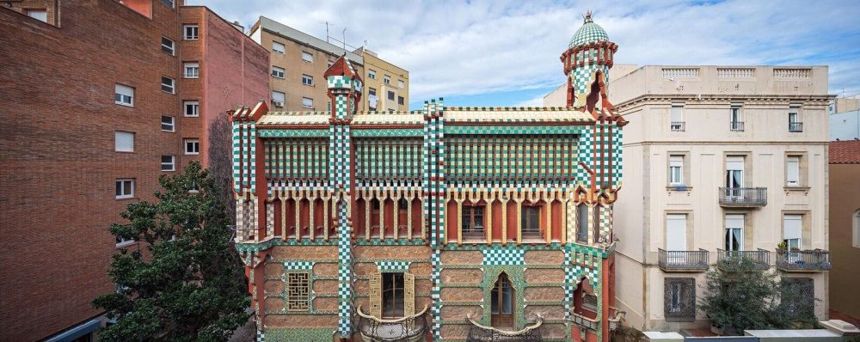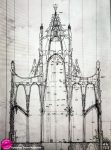By Saul Schwartz
Antoni Gaudi (1852-1926) was one of the most creative and innovative architects in the history of mankind.
Gaudi shattered conventional ideas of architecture. He created buildings that elevated the influence of nature in the man-made, reflected his faith and defied rules of symmetry. Today Gaudi is synonymous with Barcelona.
Eight of his works have been declared UNESCO World Heritage sites. His main clients were the bourgeoisie of Barcelona and the Catholic Church. The Catalan architect’s works were one primary reason we sought to explore this city. The Catalan capital has been indelibly stamped by Gaudi’s fantastic modernist buildings.
Gaudi Exhibition Center
This exhibition is a good place to begin a tour of the Gaudi route through Barcelona. The museum is centrally located in the Pia Almoina building at Pla de la Seu 7 in the gothic quarter, right next to the Barcelona Cathedral. To get to the center, we took metro line 3 to Liceu.
The center focuses on the life and work of this architect through videos, models, replicas and designs. The permanent collection is entitled “Walking with Gaudi.” This experience added to our enjoyment of the Gaudi architecture in Barcelona.
The center houses a unique collection of pieces, objects and documents by this great universal architect. After spending one hour here, we had a better understanding of Gaudi the man, his work and his revolutionary working methods. In particular, the center explains the influence of religious art, Eastern culture and classical Greco-Roman culture on Gaudi.
An audio guide was provided as part of the cost of admission (15 Euros).
La Pedrera
 Built between 1906 and 1912, this fantastic “house”, covering two blocks of residences, has been described as a masterpiece of nature. It was my favorite of the Gaudi buildings that we toured. The house was commissioned by industrialist Pere Mila as a family apartment and also for rental apartments. La Pedrera is therefore referred to as Casa Mila. La Pedrera is located at Provenca 261-265. We took metro line 3 to Diagonal and from there it was a short walk.
Built between 1906 and 1912, this fantastic “house”, covering two blocks of residences, has been described as a masterpiece of nature. It was my favorite of the Gaudi buildings that we toured. The house was commissioned by industrialist Pere Mila as a family apartment and also for rental apartments. La Pedrera is therefore referred to as Casa Mila. La Pedrera is located at Provenca 261-265. We took metro line 3 to Diagonal and from there it was a short walk.
Follow in the footsteps of Saul on his first visit to Barcelona:
The fluid exterior looks like a set of waves made of natural stone. The façade defies the laws of gravity with curved walls held in place by horizontal beams attached to invisible girders. Thirty two delicate wrought iron balconies jut out.
The tour begins within two innovative courtyards and grand ornate fairytale staircases that represent an oasis of living nature with floral ceilings and beautiful ceramic mosaics. The walls are a spectacle of shape, light and color. The building has nine levels.
The out of this world roof terrace is a unique, extraordinary creation. The incredibly original surreal rooftop overflows with artistic creativity. The sculpted skylights, stairwells, ventilation towers and chimneys are molded into attractive shapes, including medieval warriors, science fiction characters and organic forms. Some are finished with mosaics using broken tiles and bottles, stones, marble and glass. The roof provides breathtaking views over Barcelona’s Eixample neighborhood.
La Pedrera was the last major building that Gaudi finished. In 1984, La Pedrera was declared a UNESCO world heritage site. The cost of entry is 22 Euros, but the fee includes an excellent audio guide. Advance booking is recommended to avoid lines.
Casa Batllo
 Although partially under renovation, this Gaudi house has become a modern artistic myth. We took the Metro’s line 2 to Passeig De Gracia. Casa Batllo is a very short walk from the metro stop, located at Passeig de Gracia 43. This famous street includes vibrant shopping and superb modernist buildings.
Although partially under renovation, this Gaudi house has become a modern artistic myth. We took the Metro’s line 2 to Passeig De Gracia. Casa Batllo is a very short walk from the metro stop, located at Passeig de Gracia 43. This famous street includes vibrant shopping and superb modernist buildings.
Between 1904 and 1906, Gaudi dramatically renovated and refurbished an existing house purchased by textile industrialist Josep Battlo. In 1995, the house was opened to the public as an architectural gem. Under the renovation, you can see some of the exceptional modernist polychrome curvy façade, which mirrors a calm sea with green and blue colors. The current restoration will clean the exterior wood, ceramic, stone, glass and iron.
The building is playful and said to be Gaudi’s freest work. Projecting balconies are sculpted in the form of carnival masks made of wrought iron. The chimneys and rooftop are said to represent an allegory of the legend of Saint George and the dragon, with round pieces of masonry.
The 25 Euro admission includes an audio video reality guide. Advance purchase is again recommended to avoid lines. Casa Batllo is another Gaudi UNESCO heritage site.
Casa Vicens
 Gaudi’s first house project in Barcelona began with inspirations that are Catalan, English, Islamic, Japanese and English. In 2005, Casa Vicens was inscribed on the UNESCO world heritage list. Although Casa Vicens has four floors, it is of Gaudi’s smaller houses and here he experimented with shorter distances and a more intimate space.
Gaudi’s first house project in Barcelona began with inspirations that are Catalan, English, Islamic, Japanese and English. In 2005, Casa Vicens was inscribed on the UNESCO world heritage list. Although Casa Vicens has four floors, it is of Gaudi’s smaller houses and here he experimented with shorter distances and a more intimate space.
This summer house was designed in 1883-1885 by a young Gaudi for stockbroker Manuel Vicens. In 1925, the house was renovated with Gaudi’s approval to become a multi-family residence. Then the house was opened to the public in 2015. The amazing outside facades are inspired by the orient and the Islamic world, featuring decorated green and white ceramic tiles, forged iron, wood, stone and red brick. There is a checkerboard effect created by the different colored tiles. We saw cherubs, bats and reptiles perched on corner ledges. Entry is through an outside garden.
The first floor covered porch connects the interior and exterior of the house through a decorated ceiling representing the sky and leaves of the palms in the garden. In front of the main door, a cast iron palm grille represents a leaf. Other highlights include the Moorish inspired “man cave” smoking room featuring multi-colored paintings and papier mache walls, the woman’s domed room, the blue room representing a passion flower, the dining room containing a collection of 32 paintings in wood and canvas and three bedrooms designed with Mediterranean flora and fauna.
Gaudi’s first accessible rooftop is a highlight and a great vantage point for looking out over Barcelona. The colorful towers and domes (featuring red, blue, yellow, green and white) on the various corners reveal the influence of oriental architectural style. The chimneys appear to be castle turrets. The roof seems like a great place to get away and contemplate life!
The entry cost of 16 Euros includes a brochure with a self-guided tour, but there is no audio guide. Entry is on Carrier de les Carolines 20-26.
Gaudi House Museum
 Gaudi lived in this model home next to Park Guell from 1906 to 1925. The house was built to promote sales of plots on this site. Gaudi designed the layout and common services in the park as it was being promoted by an industrialist as a gardened residential area. In 1963, this building opened to the public.
Gaudi lived in this model home next to Park Guell from 1906 to 1925. The house was built to promote sales of plots on this site. Gaudi designed the layout and common services in the park as it was being promoted by an industrialist as a gardened residential area. In 1963, this building opened to the public.
The museum illustrates and evokes the architect’s private life and religious devotion through the display of personal objections, room decorations and audio visuals. In addition, the museum showcases the furniture and other objects he designed based on his observation of nature, as well as original works that reveal his design process with unusual ergonomic solutions.
The house museum borders Park Guell and a picture window was built to enable Gaudi to see the park from his dining room on the ground floor. Outside the house, a garden contains several pieces representative of his architecture in Barcelona. During the last twelve years that Gaudi lived in this house, he focused exclusively on building the Sagrada Familia.
The closest metro stop is Vallcara on line 3. From that stop, we walked up a steep hill for about ten minutes. The challenging walk provided us with great views above the city. Although tickets cost 5.5 Euros, the fees are used as a donation toward the building of the Sagrada Familia.
Sagrada Familia
 We saved our last day for Gaudi’s fantastic tour de force of the imagination and Barcelona’s top attraction. The otherworldly and monumental basilica is still a work in process. After Gaudi’s death, other architects have continued to follow his plans. Piercing the Barcelona skyline are eight of the planned gothic spires. The spires are decorated with colorful fruits. The church occupies a city block, with its given address as Carrer de Mallorca 401. The wildly unconventional church is conveniently located right at the Sagrada Familia stop on two metro lines within the Eixample neighborhood. The church is dedicated to the sacred family.
We saved our last day for Gaudi’s fantastic tour de force of the imagination and Barcelona’s top attraction. The otherworldly and monumental basilica is still a work in process. After Gaudi’s death, other architects have continued to follow his plans. Piercing the Barcelona skyline are eight of the planned gothic spires. The spires are decorated with colorful fruits. The church occupies a city block, with its given address as Carrer de Mallorca 401. The wildly unconventional church is conveniently located right at the Sagrada Familia stop on two metro lines within the Eixample neighborhood. The church is dedicated to the sacred family.
One detailed façade features the nativity and highlights through sculptures scenes related to the birth of Christ. This façade also contains about one hundred plant and animal species sculpted into stone. The two main columns are supported by turtles! A second façade features the passion and resurrection of Christ. This façade represents the pain and sacrifice of Jesus. On this façade there is a neat cryptogram where all the numbers add up to the age of Christ at the time of his death.
Inside the immense central body of the church three leaning tree-like columns with branches spread out across to meet on the vaulted ceiling. The stained glass windows are amazing! Some are yellow and orange. Others are red, blue and green. Gaudi lies in a crypt and his tomb is visible from the central nave.
We elected to enter with an official guided tour guide, at a cost of 26 Euros. The visitor fees go towards completion of the project. After the one hour tour, we were free to explore on our own.
We had to be careful as the church buzzes with construction activity and noise and scaffolding litters the site. A third façade called the Glory façade is under construction. Although incomplete, the church does hold regular Catholic services. Of course, it is another Gaudi UNESCO world heritage site.
We will consider returning to Barcelona again in 2026 to see the completion of Sagrada Familia on the one hundred year anniversary of Gaudi’s death. After visiting these sites, we were impressed how much the architectural works of one individual could have on a city.
About Saul Schwartz
 Saul lives in Alexandria, Virginia and has lived in the Washington, D.C. area since 1984. He loves to travel throughout Europe with his wife and family and particularly enjoys interacting with local residents and learning about life in their city and country.
Saul lives in Alexandria, Virginia and has lived in the Washington, D.C. area since 1984. He loves to travel throughout Europe with his wife and family and particularly enjoys interacting with local residents and learning about life in their city and country.
He has visited Berlin for one week, cruised on the Romantic Danube, wrote a 1-week city guide for London, roamed the ancient architecture of Rome and much more! Check out all Saul’s contributions.
More info
Learn more







































